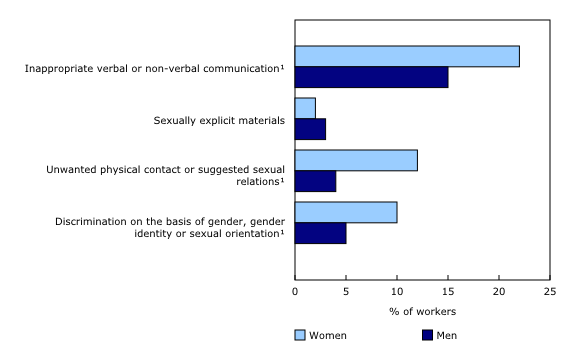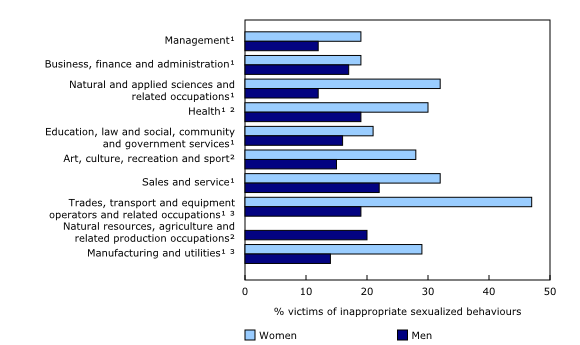In 2020, one in four women and one in six men reported having experienced inappropriate sexualized behaviours at work in the previous year
Archived Content
Information identified as archived is provided for reference, research or recordkeeping purposes. It is not subject to the Government of Canada Web Standards and has not been altered or updated since it was archived. Please "contact us" to request a format other than those available.
Released: 2021-08-12
In 2020, one in four women (25%) and one in six men (17%) reported having personally experienced inappropriate sexualized behaviours in their workplace during the previous year. Inappropriate sexualized behaviours include inappropriate verbal or non-verbal communication, sexually explicit materials, and unwanted physical contact or suggested sexual relations.
All workplaces in Canada must comply with anti-harassment and discrimination laws, and many employers have policies in place to address inappropriate sexualized behaviours in their workplaces—including procedures for reporting incidents to the appropriate people. Nevertheless, approximately one-third of women (32%) and one-quarter of men (26%) said that they had not received any information from their employer on how to report sexual harassment and sexual assault.
Based on results from the 2020 Survey on Sexual Misconduct at Work, the Juristat article, "Workers' experiences of inappropriate sexualized behaviours, sexual assault and gender-based discrimination in the Canadian provinces, 2020" is released today.
The COVID-19 pandemic has changed how many Canadians work, with shifts to remote work or working in greater isolation. One consequence of these changes is the transformation in how workers interact with their colleagues and clients. The Survey on Sexual Misconduct at Work was conducted just prior to the onset of public health measures, including the closure of many workplaces. The results of this survey therefore reflect experiences of workers prior to the pandemic, when workplaces were fully open.
One in ten women experience gender-based discrimination at work
One in ten women (10%) personally experienced workplace discrimination based on gender, gender identity or sexual orientation in the year prior to the pandemic, compared with less than one in twenty men (4%).
Women, young employees, those with disabilities or those belonging to the LGBTQ2+ community were most likely to experience inappropriate sexualized behaviours and discrimination based on gender, gender identity or sexual orientation at work. For example, almost half (47%) of LGBTQ2+ workers had personally experienced this kind of behaviour or discrimination, compared with just over one-fifth (22%) of non-LGBTQ2+ workers.
Workers belonging to a visible minority population were less likely than non-visible minority workers to report having experienced gender-based discrimination at work. This was the case for visible minority women (8% of whom experienced gender-based discrimination, compared with 11% of non-visible minority women) and visible minority men (4%, versus 5%). Findings were similar for inappropriate sexualized behaviours at work: these were experienced by 19% of visible minority women and 11% of visible minority men, proportions that were smaller than among their non-visible minority counterparts (27% and 19%, respectively).
Reports of inappropriate sexualized behaviours at work were as common among Indigenous women (25%) as they were among non-Indigenous women (25%), and proportions were similar between Indigenous men (20%) and non-Indigenous men (16%). Indigenous women were also as likely as non-Indigenous women to report having experienced gender-based discrimination at work (10% respectively).
Inappropriate sexualized behaviour more common for women in occupations historically held by men
For women, experiences of inappropriate sexualized behaviour were most common for those working in certain occupations where men have historically outnumbered women. For example, almost half (47%) of women working in trades, transportation, equipment operation and related occupations said that they experienced inappropriate sexualized behaviour at work in the year leading up to the pandemic―compared with 19% of men.
Women and men in health, sales and service jobs experience high rates of inappropriate sexualized behaviours
Women working in some occupations where they historically outnumbered men also experienced high rates of inappropriate sexualized behaviours in the year leading up the pandemic. For example, almost one in three women working in sales and service (32%) and health-related occupations (30%) said that they had been targeted with inappropriate sexualized behaviours at work in the previous year.
By way of comparison, about one in five men in sales and service (22%) and health care (19%) occupations had personally experienced inappropriate behaviours in the previous year.
Over half (53%) of women in sales and service occupations who had experienced these behaviours said that a customer or client had been responsible for at least one incident, compared with just over one-fifth of men (21%). Conversely, men who experienced these behaviours were much more likely to be targeted by a co-worker (83%) than women (64%).
One in three women targeted with sexually explicit materials at work says someone in authority was responsible
People with formal authority in the workplace―such as supervisors and bosses―were often the perpetrators of inappropriate sexualized behaviours in the year prior to the pandemic. For example, about three in ten women (28%) who were targeted with sexually explicit materials at work identified someone in authority as responsible, as did 30% of men who experienced unwanted physical contact or suggested sexual relations.
In terms of gender-based discrimination in the workplace, 44% of women and 36% of men who had been targeted said that it had been perpetrated by someone in authority.
Women most often identified a man as the perpetrator of all three types of inappropriate sexualized behaviour. While this was also true for men targeted with sexually explicit materials (66%), about half of men (51%) who experienced unwanted physical contact or suggested sexual relations said that the perpetrator was a woman.
Many women do not speak out about their experiences for fear of negative impact on their career
As with inappropriate sexualized behaviours and sexual assaults that happen in other contexts, not all instances that occurred in the workplace were reported to someone in authority. For example, about half of women (51%) who had experienced inappropriate communication in the workplace in the year prior to the pandemic discussed the incident with someone at work, and a supervisor or boss was that person in less than half of these instances (46%). A much smaller proportion of men (20%) chose to speak to someone about their experience, and of those who did, about four in ten (39%) brought it up to a supervisor or boss.
One in five women (20%) who did not speak to someone about inappropriate communication that they experienced at work, stated that they feared negative consequences for their careers if they did so―a considerably higher proportion than among men (8%). Just over one-quarter of the women (26%) thought that no action would be taken if they reported inappropriate communication, and 12% stated that they were too embarrassed or ashamed to discuss what happened.
Among men who did not report inappropriate communication, about one-quarter (26%) stated that they did not do so because they did not see the behaviour as inappropriate.
Note to readers
The 2020 Survey on Sexual Misconduct at Work (SSMW) collected information on inappropriate sexualized behaviours, discrimination based on actual or perceived gender, gender identity and sexual orientation, and sexual assault that happened in a work-related setting. A work-related setting is defined as any place where a person performs work activities for their job or business, or interacts with people associated with their work (such as during work-related social events). This includes incidents that happened over the phone or online.
The survey measured 15 individual inappropriate sexualized and discriminatory behaviours, which are grouped into four categories for the purposes of analysis: inappropriate verbal or non-verbal communication, sexually explicit materials, unwanted physical contact or suggested sexual relations, and discrimination on the basis of actual or perceived gender, gender identity or sexual orientation. The survey also measured three types of sexual assault: sexual attacks, unwanted sexual touching, and sexual activity to which a person is unable to consent, because they were coerced, manipulated, intoxicated or forced in another non-physical way.
Individuals aged 15 years and older and living in the Canadian provinces were surveyed, while members of the Canadian Armed Forces, individuals residing in the territories, on reserve or in institutions were excluded. The terms "women" and "men" include both cisgender and transgender women and men.
The development and collection of the SSMW and the analysis of its results was funded by Women and Gender Equality Canada.
For information on the methodology of the survey, see: Survey on Sexual Misconduct at Work.
Some estimates in this article should be used with caution; for more information, please refer to the Juristat article Workers' experiences of inappropriate sexualized behaviours, sexual assault and gender-based discrimination in the Canadian provinces, 2020
Products
The article "Workers' experiences of inappropriate sexualized behaviours, sexual assault and gender-based discrimination in the Canadian provinces, 2020" is now available as part of the publication Juristat (Catalogue number 85-002-X). The infographic "Sexual misconduct and gender-based discrimination at work, 2020" (Catalogue number 11-627-M) is also released today.
Contact information
For more information, or to enquire about the concepts, methods or data quality of this release, contact us (toll-free 1-800-263-1136; 514-283-8300; STATCAN.infostats-infostats.STATCAN@canada.ca) or Media Relations (613-951-4636; STATCAN.mediahotline-ligneinfomedias.STATCAN@canada.ca).
- Date modified:



